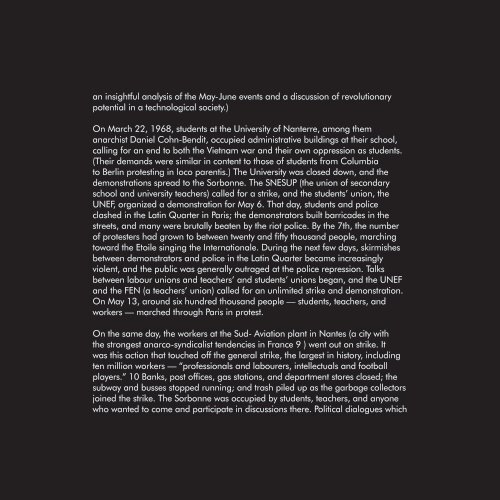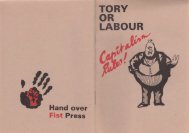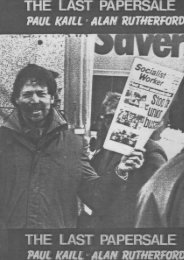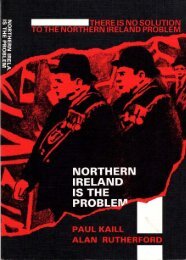- Page 1:
HAND OVER FIST PRESS SHEEP IN THE R
- Page 5 and 6:
This Volume’s CONTENTS ----------
- Page 7 and 8:
ANOTHER OPENING -------------------
- Page 9:
HAND OVER FIST PRESS SHEEP IN THE R
- Page 12 and 13:
& again, its money money money
- Page 14 and 15:
d SHEEP IN THE ROAD : NUMBER 18
- Page 17 and 18:
OPENING ---------------------------
- Page 19 and 20:
TRUMP TRUMP QUACK Donald Trump is b
- Page 21 and 22:
Under law and procedures, such cove
- Page 23 and 24:
President-elect George W. Bush did
- Page 25 and 26:
WHEN ELEPHANTS FIGHT ITS THE GRASS
- Page 27 and 28:
FIDEL CASTRO (1926-2016) Fidel Cast
- Page 29 and 30:
15 XMAS 2016
- Page 31 and 32:
10 LIES ABOUT THE XMAS CONSUMERIST
- Page 33 and 34:
adding in brackets, ‘We’re nice
- Page 35 and 36:
never have too many hats, gloves, a
- Page 37 and 38:
Why haven’t we revolted against c
- Page 39 and 40:
25 Artwork: Alan Rutherford XMAS 20
- Page 41 and 42:
BORN A CRIME Trevor Noah charts his
- Page 43 and 44:
‘Their fathers were off working i
- Page 45 and 46:
31 XMAS 2016
- Page 47 and 48:
33 XMAS 2016
- Page 49 and 50:
35 XMAS 2016
- Page 51 and 52:
37 XMAS 2016
- Page 53 and 54:
JOANA FOSTER ‘She made African wo
- Page 55 and 56:
the country director of Cuso, Ghana
- Page 57 and 58:
IT’S A FUCKING EVIL CRIME! AND YE
- Page 59 and 60:
DIRTY LAUNDRY WASHING LINE ART HIGH
- Page 61 and 62:
Carmen Ives, a volunteer who helped
- Page 63 and 64:
49 Activists Nondumiso Msimanga and
- Page 65 and 66:
deep breath comrades ... capitalism
- Page 67 and 68:
Why trump Won | r.w. johnson the ro
- Page 69 and 70:
WAFFLE ----------------------------
- Page 71 and 72:
HAND OVER FIST PRESS SHEEP IN THE R
- Page 73 and 74:
& you still can’t take it with yo
- Page 75:
The CONTENTS ----------------------
- Page 78 and 79:
4 SHEEP IN THE ROAD : NUMBER 20
- Page 80 and 81:
... the main again: war freedom is
- Page 82 and 83:
And look at Israel. The new US amba
- Page 84 and 85:
The claim by the Leave side in the
- Page 86 and 87:
Contempt lies deep in the antechamb
- Page 88 and 89:
its fucking 2017! 14 SHEEP IN THE R
- Page 90 and 91:
A TRUMP RACE & HORSE-SENSE EUGENICS
- Page 92 and 93:
The Huffington Post also took the l
- Page 94 and 95:
Session opposes ‘guest worker pro
- Page 96 and 97:
A third selection is Rep. Mike Pomp
- Page 98 and 99:
24 Jonathan Shapiro (Zapiro), born
- Page 100 and 101:
26 SHEEP IN THE ROAD : NUMBER 20
- Page 102 and 103:
Christmas may be over, but for Jews
- Page 104 and 105:
30 SAM STONE SHEEP IN THE ROAD : NU
- Page 106 and 107:
There’s a hole in daddy’s arm w
- Page 108 and 109:
34 AN INTERESTING PAMPHLET SHEEP IN
- Page 110 and 111:
¡No pasarán! The ITF and the figh
- Page 112 and 113:
38 An Italian poster produced by IT
- Page 114 and 115:
There is a memorial plaque at the h
- Page 116 and 117:
42 International Brigader and Liver
- Page 118 and 119:
During the Spanish Civil War a grou
- Page 120 and 121:
Prominent Belgian trade unionist Om
- Page 122 and 123:
48 Published in Antwerp, the anti-f
- Page 124 and 125:
50 Edo Fimmen (above) and Nathan Na
- Page 126 and 127:
52 For more information ●‘The I
- Page 128 and 129:
¡No pasarán! The ITF and the figh
- Page 130 and 131:
56 Crikey ... a virtual keyboard, u
- Page 132 and 133:
58 Writing worth reading Photos wor
- Page 134 and 135:
Artwork: still unknown oi editor ..
- Page 136 and 137:
HAND OVER FIST PRESS 2 0 1 7
- Page 138 and 139:
Ah, money money money in a rich man
- Page 140 and 141:
d SHEEP IN THE ROAD : NUMBER 21
- Page 142 and 143:
... the main poin again: war is pe
- Page 144 and 145:
4 SHEEP IN THE ROAD : NUMBER 21
- Page 146 and 147:
are, as enough of it panders to an
- Page 148 and 149:
Berger’s art criticism, for me, f
- Page 150 and 151:
10 SHEEP IN THE ROAD : NUMBER 21
- Page 152 and 153:
12 In his book’s preface, Hyman w
- Page 154 and 155:
Another way Hyman’s contemporary
- Page 156 and 157:
16 SHEEP IN THE ROAD : NUMBER 21
- Page 158 and 159:
18 Yet it was quickly clear to men
- Page 160 and 161:
20 SHEEP IN THE ROAD : NUMBER 21
- Page 162:
Royal Academy of Arts REVOLUTION: R
- Page 165 and 166:
FREE FLIGHT GROUNDED & SQUASHED THE
- Page 167 and 168:
ON 27 PHOTOGRAPHS ALAN RUTHERFORD T
- Page 169 and 170:
29 FEBRUARY 2017
- Page 171 and 172:
31 FEBRUARY 2017
- Page 173 and 174: 33 FEBRUARY 2017
- Page 175 and 176: 35 FEBRUARY 2017
- Page 177 and 178: 37 FEBRUARY 2017
- Page 179 and 180: 39 FEBRUARY 2017
- Page 181 and 182: 41 FEBRUARY 2017
- Page 183 and 184: The LAW CENTRE in Gloucester: the e
- Page 185 and 186: 45 Posters: Alan Rutherford, 1987 S
- Page 187 and 188: 47 FEBRUARY 2017
- Page 189 and 190: 49 CHELTENHAM 1987 FEBRUARY 2017
- Page 191 and 192: 51 FEBRUARY 2017
- Page 193 and 194: 53 FEBRUARY 2017
- Page 195 and 196: her ell ... mes 55 on of the Missio
- Page 197 and 198: 57 FEBRUARY 2017
- Page 199 and 200: 59 FEBRUARY 2017
- Page 201 and 202: 61 FEBRUARY 2017
- Page 203 and 204: deep breath comrades ... capitalism
- Page 205 and 206: 65 FEBRUARY 2017
- Page 207 and 208: WAFFLE ----------------------------
- Page 209 and 210: HAND OVER FIST PRESS SHEEP IN THE R
- Page 211 and 212: it is so funny, that you fuckers ca
- Page 213 and 214: The CONTENTS ----------------------
- Page 215 and 216: ts ace, ry, ngth the t OPENING ----
- Page 217 and 218: TRUMPMEN From the African American
- Page 219 and 220: sh-i-i-i-t! that ben did a top job
- Page 221 and 222: BEYOND THEORY Spain 1936-39, France
- Page 223: initiative. In the factories and vi
- Page 227 and 228: in the years prior to 1968 as it wa
- Page 229 and 230: 17 MARCH 2017
- Page 231 and 232: 19 MARCH 2017
- Page 233 and 234: 21 MARCH 2017
- Page 235 and 236: 23 MARCH 2017
- Page 237 and 238: Artwork Brian David Rutherford 1950
- Page 239 and 240: TRADE UNION PAMPHLET FROM 1951 27 M
- Page 241 and 242: 29 MARCH 2017
- Page 243 and 244: 31 MARCH 2017
- Page 245 and 246: 33 MARCH 2017
- Page 247 and 248: 35 MARCH 2017
- Page 249 and 250: 37 MARCH 2017
- Page 251 and 252: 39 MARCH 2017
- Page 253 and 254: 41 MARCH 2017
- Page 255 and 256: 43 MARCH 2017
- Page 257 and 258: 45 MARCH 2017
- Page 259 and 260: 47 MARCH 2017
- Page 261 and 262: 49 MARCH 2017
- Page 263 and 264: 51 MARCH 2017
- Page 265 and 266: 53 MARCH 2017
- Page 267 and 268: 55 MARCH 2017
- Page 269 and 270: 57 MARCH 2017
- Page 271 and 272: 59 MARCH 2017
- Page 273 and 274: 61 MARCH 2017
- Page 275 and 276:
63 MARCH 2017
- Page 277 and 278:
65 MARCH 2017
- Page 279 and 280:
67 MARCH 2017
- Page 281 and 282:
69 MARCH 2017
- Page 283 and 284:
71 MARCH 2017
- Page 285 and 286:
73 MARCH 2017
- Page 287 and 288:
75 MARCH 2017
- Page 289 and 290:
77 MARCH 2017
- Page 291 and 292:
79 MARCH 2017
- Page 293 and 294:
81 MARCH 2017
- Page 295 and 296:
83 MARCH 2017
- Page 297 and 298:
85 MARCH 2017
- Page 299 and 300:
87 MARCH 2017
- Page 301 and 302:
89 MARCH 2017
- Page 303 and 304:
91 MARCH 2017
- Page 305 and 306:
93 MARCH 2017
- Page 307 and 308:
95 MARCH 2017
- Page 309 and 310:
97 MARCH 2017
- Page 311 and 312:
99 MARCH 2017
- Page 313 and 314:
101 MARCH 2017
- Page 315 and 316:
103 MARCH 2017
- Page 317 and 318:
105 MARCH 2017
- Page 319 and 320:
st maybe? happen eland’ t? There
- Page 321 and 322:
deep breath comrades ... capitalism
- Page 323 and 324:
111 MARCH 2017
- Page 325 and 326:
WAFFLE ----------------------------
- Page 327 and 328:
HAND OVER FIST PRESS SHEEP IN THE R
- Page 329 and 330:
it is priceless, that you fuckers c
- Page 331 and 332:
The CONTENTS ----------------------
- Page 333 and 334:
ts ace, ry, ngth the t OPENING ----
- Page 335 and 336:
5 APRIL 2017
- Page 337 and 338:
A PAIR OF BROWN EYES One summer eve
- Page 339 and 340:
9 APRIL 2017
- Page 341 and 342:
CASTLE CABS: SMOKING KILKENNY Marti
- Page 343 and 344:
13 APRIL 2017
- Page 345 and 346:
15 APRIL 2017
- Page 347 and 348:
17 APRIL 2017
- Page 349 and 350:
Thanks Martin: good photographs, bu
- Page 351 and 352:
FEAT OF CLAY Wandering about Stroud
- Page 353 and 354:
23 APRIL 2017
- Page 355 and 356:
Clay, here is a question: how do yo
- Page 357 and 358:
A WEAVER’S REBELLION leaf 5: Riot
- Page 359 and 360:
29 APRIL 2017
- Page 361 and 362:
31 APRIL 2017
- Page 363 and 364:
A NEW REFUTATION OF THE VIKING 4 SP
- Page 365 and 366:
13 Mrs. Lee. Leeds, 1975 35 APRIL 2
- Page 367 and 368:
PEEPER by Raisin Wind My reward for
- Page 369 and 370:
39 APRIL 2017
- Page 371 and 372:
JUST 41 FLOATING ONE APRIL 2017
- Page 373 and 374:
ARTHUR BEAGLE’S DIARY 43 www.hand
- Page 375 and 376:
45 APRIL 2017
- Page 377 and 378:
WAFFLE ----------------------------
- Page 379:
HAND OVER FIST PRESS SHEEP IN THE R
- Page 382 and 383:
d SHEEP IN THE ROAD : NUMBER 24
- Page 384 and 385:
... the main poin again: war is pe
- Page 386 and 387:
4 SHEEP IN THE ROAD : NUMBER 24
- Page 388 and 389:
6 Although the Turkish electorate c
- Page 390 and 391:
SOUK by P 8 SHEEP IN THE ROAD : NUM
- Page 392 and 393:
Chokin’ clouds f dust settle on t
- Page 394 and 395:
Just a thought, what if someone had
- Page 396 and 397:
14 SHEEP IN THE ROAD : NUMBER 24
- Page 398 and 399:
16 SHEEP IN THE ROAD : NUMBER 24
- Page 400 and 401:
18 SHEEP IN THE ROAD : NUMBER 24
- Page 402 and 403:
20 SHEEP IN THE ROAD : NUMBER 24
- Page 404 and 405:
22 SHEEP IN THE ROAD : NUMBER 24 FO
- Page 406 and 407:
24 SHEEP IN THE ROAD : NUMBER 24
- Page 408 and 409:
26 Tamerlane’s Tatars in 1401, wh
- Page 410 and 411:
PE 28 SHEEP IN THE ROAD : NUMBER 24
- Page 412 and 413:
30 SHEEP IN THE ROAD : NUMBER 24
- Page 414 and 415:
Touching a raw nerve, Hone’s pamp
- Page 416 and 417:
34 SHEEP IN THE ROAD : NUMBER 24
- Page 418 and 419:
36 SHEEP IN THE ROAD : NUMBER 24
- Page 420 and 421:
and anti-establishment credentials
- Page 422 and 423:
40 SHEEP IN THE ROAD : NUMBER 24
- Page 424 and 425:
42 SHEEP IN THE ROAD : NUMBER 14
- Page 426 and 427:
44 Writing worth reading Photos wor
- Page 428 and 429:
Artwork: still unknown oye matey ed
- Page 430 and 431:
HAND OVER FIST PRESS BOOKS • MAGA
- Page 432:
HAND OVER FIST PRESS 2 0 1 7

















